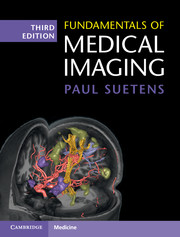Book contents
5 - Nuclear Medicine Imaging
Published online by Cambridge University Press: 13 July 2017
Summary
Introduction
The use of radioactive isotopes for medical purposes has been investigated since 1920, and since 1940 attempts have been undertaken to image radionuclide concentration in the human body. In the early 1950s, Ben Cassen introduced the rectilinear scanner, a “zero-dimensional” scanner, which (very) slowly scanned in two dimensions to produce a projection image, like a radiograph, but this time of the radionuclide concentration in the body. In the late 1950s, Hal Anger developed the first “true” gamma camera, introducing an approach that is still being used in the design of all modern cameras: the Anger scintillation camera, a 2D planar detector to produce a 2D projection image without scanning.
The Anger camera can also be used for tomography. The projection images can then be used to compute the original spatial distribution of the radionuclide within a slice or a volume, in a process similar to reconstruction in X-ray computed tomography. Already in 1917, Radon published the mathematical method for reconstruction from projections, but only in the 1970s was the method applied in medical applications – first to CT, and then to nuclear medicine imaging. At the same time, iterative reconstruction methods were being investigated, but the application of those methods had to wait until the 1980s for sufficient computer power.
The preceding tomographic system is called a SPECT scanner. SPECT stands for single photon emission computed tomography. Anger also showed that two scintillation cameras could be combined to detect photon pairs originating after positron emission. This principle is the basis of PET (i.e., positron emission tomography), which detects photon pairs. Ter-Pogossian et al. built the first dedicated PET system in the 1970s, which was used for phantom studies. Soon afterward, Phelps, Hoffman et al. built the first PET scanner (also called PET camera) for human studies. The PET camera has long been considered almost exclusively as a research system. Its breakthrough as a clinical instrument dates only from the last decade.
- Type
- Chapter
- Information
- Fundamentals of Medical Imaging , pp. 120 - 146Publisher: Cambridge University PressPrint publication year: 2017



